A Soviet Spa Town: Tskaltubo
The Spa Town of Tskaltubo, not far from Kutaisi was a place for rest and relaxation during Soviet times. Here people took advantage of the healing natural spring waters in the more than 20 spa resorts which housed, treated and entertained visitors who stayed for week or two.
A Place for Holidays
The pleasures of spa treatments and holidays wasn’t reserved for wealthy Soviets and government officials. In the beginning, at least, people from certain occupations, including miners were given ‘compulsory holidays’ in Tskaltubo. They arrived by train with their families to enjoy the pleasures offered by the spa resorts.
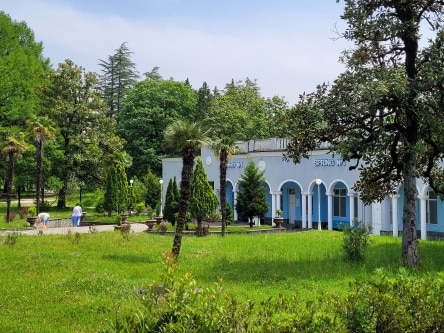
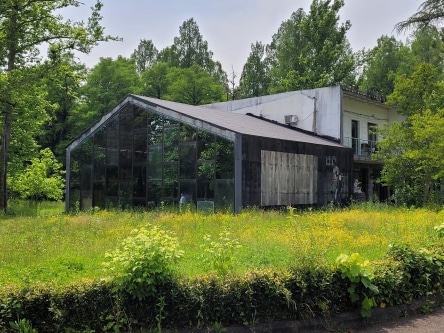
I’ve discovered that many people still revere Stalin. They miss the free education, free medical care and the regular work that they enjoyed during Soviet times. Those who holidayed at Tskaltubo recall their holidays there fondly.
The Resorts are Abandoned
When the Soviet Union collapsed in 1991, most of the spa resorts were abandoned and left to the ravages of nature. Locals, and later internally displaced persons, who lived in the town had inadequate heating in their homes and stripped the buildings of wooden fixtures and furnishings for firewood.
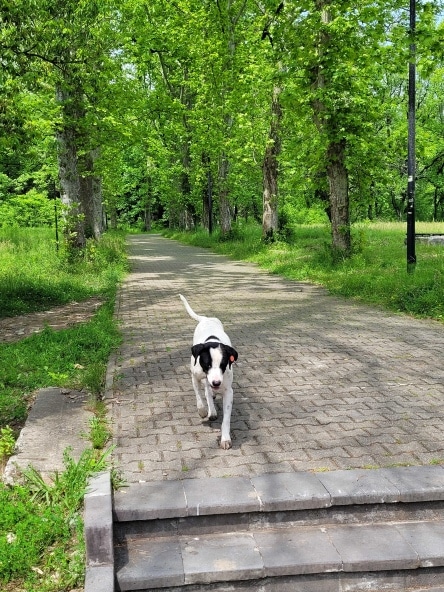

The buildings became a haunt for Urban Explorers. Some were turned into housing for internally displaced Abkhazians. They have mostly been rehoused. Private investors bought many of the resorts with a view to either knocking them down and replacing them with hotels or restoring them to their former glory.
Visiting the Georgian Spa Town
In May 2023 (things may have changed), I was fortunate to spend an afternoon in Tskaltubo. We visited Spring Number 6, one of the few working Spa and Treatment Resorts; the abandoned Sanatorium Medea and the fenced off Sanatorium Shakhtiori or Miner’s Sanatorium.
Walking through Central Park, Ketti, our guide, comments that surprisingly the trees here weren’t cut down for firewood during soviet times. A friendly street dog follows us as we walk along the paved path in dappled shade. Like many of the Georgian street dogs, this one has a tag in its ear. The tag means it has been vaccinated and desexed.

We walk past the relatively newly painted Spring No 1, and an abandoned building, before reaching a street where two locals have set up street stalls selling home baked goods.
Spring Number 6
Spring No 6 is one of the handful of spas that have been restored and are open for business. Tall white columns mark the entrance. Above the pale pink panels in the façade, a frieze depicts Stalin shaking hands with a woman holding a young child.
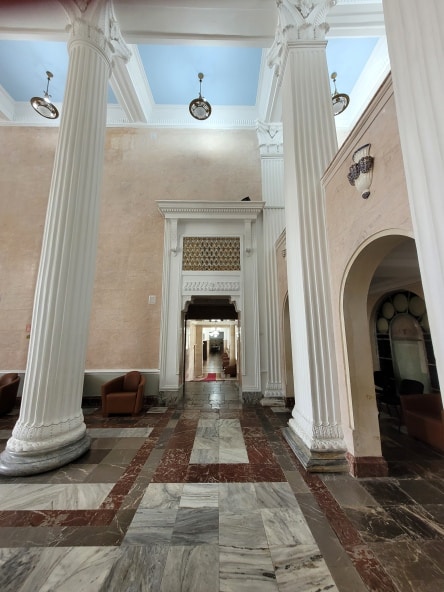

Stalin is reputed to have visited Tskaltubo twice, but these claims are not substantiated.
Treatments
Inside the cavernous entrance hall, we crowd around an easel covered in printed white sheets. They list, in Russian, Georgian and English, the various treatments offered at the spa “for one-time visitors.”
Women in our group chuckle uncomfortably when we read that we could have a “gynecologic [sic] irrigation” for GEL30 (≈AU$18). Colon hydrotherapy (deep intestinal lavage) will cost GEL 95 (≈AU$57). A consultation with the Head Doctor will cost GEL30. His rooms are behind a dark wooden door off the entrance hall.

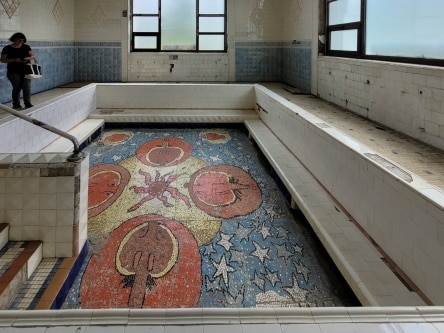
A woman dressed in a white tunic, pants and sneakers comes over to assist us. She explains that “Gloves” means a mud application to the hands and “Socks’ is the same for the feet. I’m tempted. After all it’s less than AU$12 and I’m always open to trying something new. But I haven’t come prepared to shower and anyway, we really don’t have the time.
Exploring Spring No 6
We’re lucky. The woman helpfully shows us one of the spa baths. Then, after pointing us in the direction of ‘Stalin’s bath’, she leaves us to explore independently. The staff aren’t always so helpful to tourists.
It’s unclear whether or not Stalin ever did visit, but the bath was built for his use. A largely intact mosaic depicting pomegranates and stars on a blue background decorates the floor of the large spa bath. White wall tiles have fallen off and generally the room is in a state of disrepair.

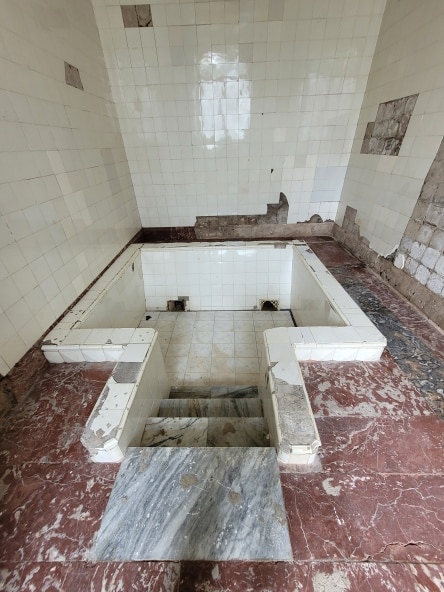
We walk through finely restored areas of Spring No 6 and other sections that are worn and tired.
A man, casually dressed in track suite pants and a t-shirt, walks past us to the lift. He presses the button. In his hand he carries a plastic bag with rounds of bread and other food items. He’s staying here for a few days.
Sanatorium Medea
The second sanatorium couldn’t be more different from Spring No 6. Abandoned and covered in mould and grime, it is nevertheless an imposing building. Two staircases lead up to a large protruding balcony where three-storey-high arched columns hint at past grandeur.

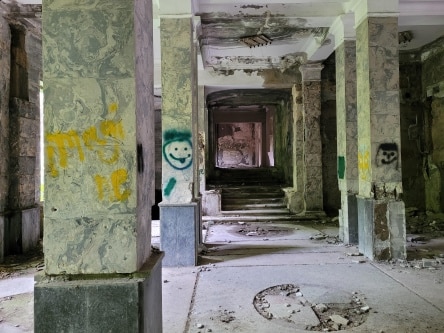
Flashes of colour brighten the spaces between the weathered stone columns and broken balustrades of Sanatorium Medea. Young women dressed in long shiny off the shoulder gowns balance on high heels as they pick their way over the concrete floor.
A Haven for Urban Explorers
Sanatorium Medea is a haven for urban explorers, photographers and, as we discover, graduating students. The young folk tell us that they had their “last bell” at 12pm yesterday and will celebrate with their prom later today.


But first, it’s photo and video time. One tells me she spent GEL1000 on her dress. That’s about AU$1100. Another stands out in her black pants suit. She has a row of gold safety pin earrings down one ear lobe. Her blonde bob is smoothly slicked back over her head. A mother of one of the girls, she’s pleased to be mistaken for one of them.

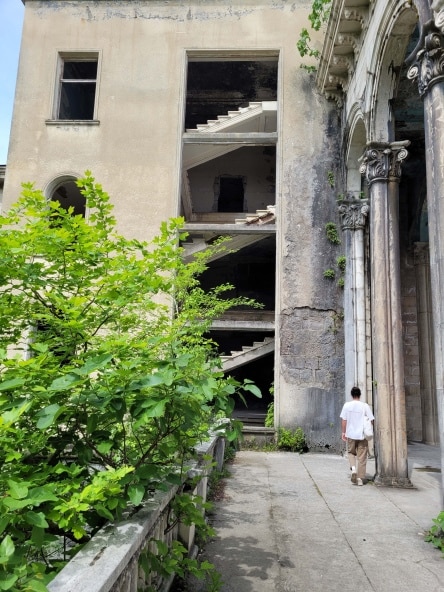
Not yet in the hands of developers, the abandoned building is free to explore. Avoiding photographers and videographers, we wander around the dilapidated building. We stay away from the stairs to upper levels. They are decaying and unsafe.
Sanatorium Shakhtiori, the Miner’s Sanatorium
High green metal fencing surrounds the Miner’s Sanatorium. The only way to see it from the outside is to climb a ladder. Built by German military prisoners in the 1950s, an investor, possibly or probably a Russian Oligarch, has recently bought the abandoned palatial building.
We get Inside the Miner’s Sanatorium
It may be off-limits, but (don’t ask how) we manage to get inside. We excitedly hurry across the untended lawns to a side entrance of the derelict building, soon to be renovated or pulled down. We’ve entered at our own risk and our tour leader warns us to take care.


Broken glass crunches beneath my feet. A few loose wooden parquet tiles lie scattered at room entrances. Looters have removed many of the tiles, probably to burn as firewood. A dusty empty wooden stage hints at shows put on for guests of the sanatorium.


I’ve seen a recent photograph of a red stage curtain hanging limply at the side of the stage. That is no longer there. Apart from a broken armchair with torn brown upholstery, the grand halls are empty of furniture.


Yellow paint peels from the walls while the painted ceiling decorations are remarkably well-preserved.
I’d Love to Explore this Soviet Spa Town Further
All too soon, we must return to the bus. If I ever return to Georgia, I will try to spend more time in Tskaltubo. I’d love to hear more of the stories hidden in the walls of the buildings which may soon be changed forever.

Read more about this fascinating place here.

Love those photos.
Jo, these buildings represent a “golden goose” tourist opportunity for the region. But I guess it’s doubtful that the “locals” will be the main beneficiaries!
Thanks Robyn. You’re right. The oligarchs appear to be the winners here.
Wow, Joanne, those photos, the faded grandeur. Astounding. I would love to visit, always love a spa though would not be keen on any irrigations at all!!
Faded grandeur indeed, Seana. The irrigations sound … well scary!
The cost of any one of those building must have been high based on the marble, mosaic, columns etc., however the soviets in their typical fashion saved by using prisoners for labor. Very interesting read and beautiful photographs.
Georgia is fascinating, Bernadette. I’d happily go back!